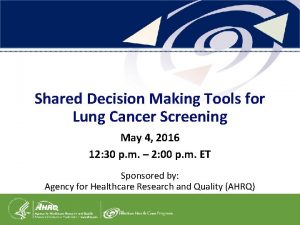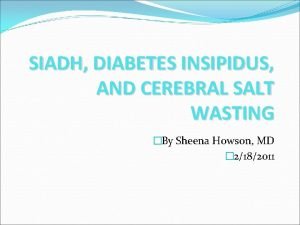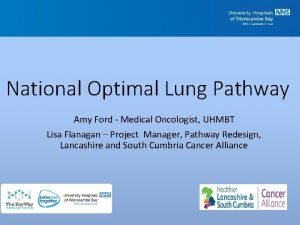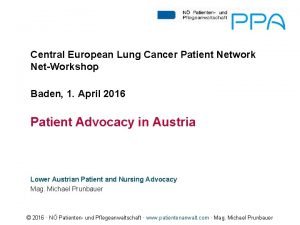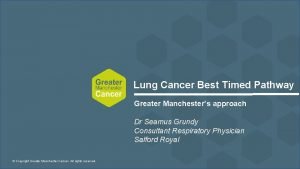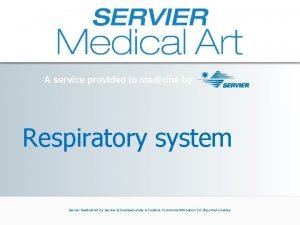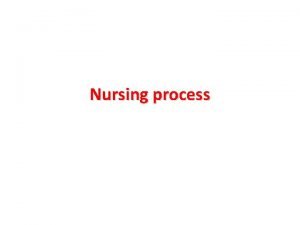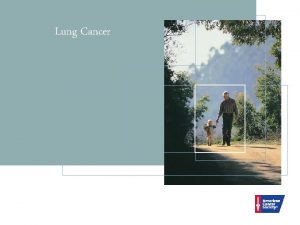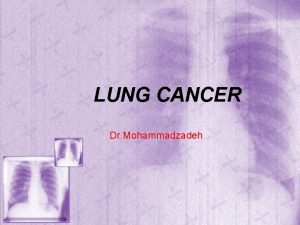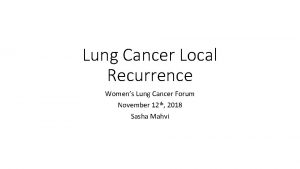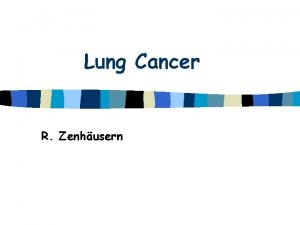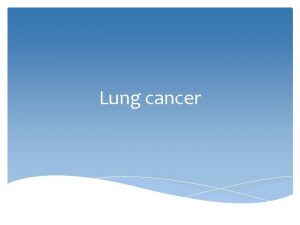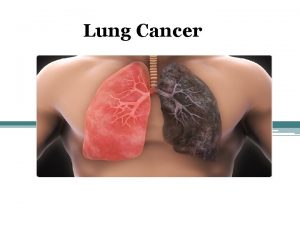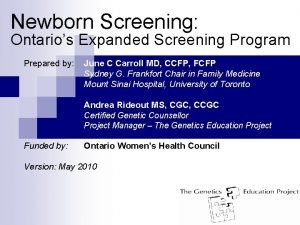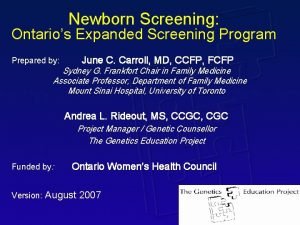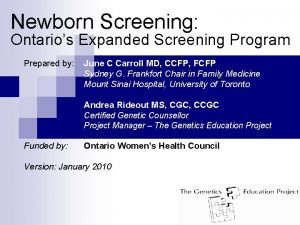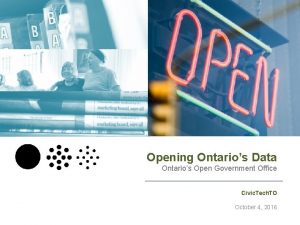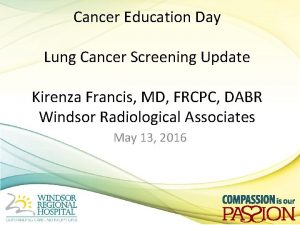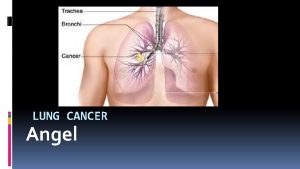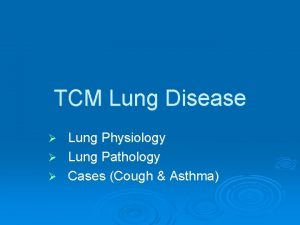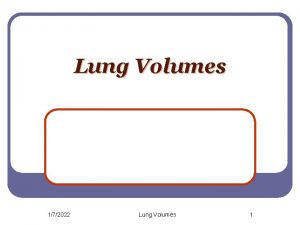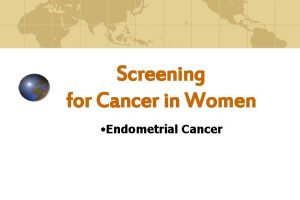Ontarios Lung Cancer Screening Pilot for People at











































- Slides: 43

Ontario’s Lung Cancer Screening Pilot for People at High Risk PRESENTER: DR. GAIL DARLING Presentation for the Northeast Oncology Conference Sudbury, Ontario November 15, 2019

Disclosure of Affiliations, Financial Support, and Mitigating Bias Speaker Name: Dr. Gail Darling Affiliations: I have no relationships with for-profit or not-for-profit organizations. Financial Support: This session/program has not received financial or in-kind support. 2

CONFIDENTIAL Do not publish or disseminate the contents of this presentation including First Nations, Inuit, Métis data (if applicable) without the consent of Cancer Care Ontario. This presentation contains de-identified and/or aggregate information (the “Information”). Recipients of this presentation acknowledge and agree that they will not use the Information, either alone or with other information to: identify an individual; attempt to decrypt information that is encrypted; attempt to identify an individual based on unencrypted information; or attempt to identify an individual based on prior knowledge. 3

Agenda 1. Overview of Lung Cancer Screening Evidence & Burden of Disease 2. Objectives and Site Locations of the Lung Cancer Screening Pilot for People at High Risk (the pilot) 3. Screening Pathway Overview and Tools 4. Early Results 5. Next Steps 6. Q&A 4

Learning Objectives 1. Examine evidence for lung cancer screening and components of organized lung cancer screening 2. Describe recruitment strategies and importance of navigation 3. Recognize opportunities for smoking cessation interventions within the screening process 5

Overview of Lung Cancer Screening Evidence & Burden of Disease 6

The Importance of Lung Cancer Screening • Leading cause of cancer death for women and men in Ontario 1 • Lung cancer is usually diagnosed at an advanced stage, when treatment has less of a chance of working • Screening can find lung cancer earlier, when treatment has a better chance of working 1. Cancer Care Ontario Cancer Statistics 2018 [Internet]. Toronto (ON): Cancer Care Ontario; 2018 [cited 2018 Nov 2]. Available from: https: //www. cancercareontario. ca/sites/ccocancercare/files/assets/OCS 2018_1. pdf 7

Lung Cancer Indicators: North East Local Health Integration Network (LHIN) North East LHIN Ontario Age-standardized incidence of lung cancer (per 100, 000 people) (2018 estimate) 95. 6 69. 7 Age-standardized 5 -year relative survival of lung cancer (2009– 2013) 18. 8% 20. 8% % of adults (age 20+) who are daily or occasional smokers (2015) 26. 4% 18. 5% Indicator (total population)2 2. Csqi. on. ca. [Internet]. Local Health Integration Network. Toronto: Cancer Care Ontario; [cited 2018 Nov 6]. Available 8 from: https: //www. csqi. on. ca/indicators/by-lhin

National Lung Screening Trial (NLST) Evidence from the NLST 3 3 • Randomized controlled trial with over 50, 000 participants ages 55– 74 at randomization • Compared screening with a low-dose computed tomography (LDCT) scan to screening with a chest X-ray • Screening people at high risk for lung cancer with LDCT resulted in a 20% relative reduction in lung cancer mortality over 6 years 3. Aberle D, Adams A, Berg C, Black W, Clapp J, Fagerstrom RM, et al. Reduced lung-cancer mortality with low-dose computed tomographic screening. N Engl J Med. United States; 2011 Aug 4; 365(5): 395– 409 9

Dutch-Belgian Randomized Lung Cancer Screening Trial (NELSON study) Evidence from the NELSON Study 4 • Randomized controlled trial with over 15, 000 participants • Compared people at high risk for lung cancer who got screened with computed tomography (CT) at four different time points to people who did not get screened • For men, screening with CT resulted in a 26% reduction in lung cancer mortality after 10 years of follow-up • For women, there was a significant and larger reduction in lung cancer mortality compared to men 4. International Association for the Study of Lung Cancer (IASLC). NELSON study shows CT screening for nodule volume management reduces lung cancer mortality by 26 percent in men [Internet]. 2018 [cited 2019 Jun]. Available from: https: //wclc 2018. iaslc. org/media/2018 WCLC Press Program Press Release De Koning 9. 25 FINAL. pdf 10

Objective and Site Locations of the Pilot 11

Pilot Objective and Site Locations Pilot organized lung cancer screening for people at high risk, using LDCT, to inform design and implementation of a provincial program 12

Screening Pathway Overview and Tools 13

Key Aspects of Pilot Design Provider and public recruitment strategies Eligibility based on a risk prediction model 5 RECRUITMENT Navigation RISK ASSESSMENT Radiology quality Lung-RADSTM assurance (QA) SMOKING CESSATION RADIOLOGY Seamless transition to diagnostic assessment DIAGNOSIS 5. Tammemägi MC, Katki HA, Hocking WG, Church TR, Caporaso N, Kvale PA, et al. Selection criteria for lung -cancer screening. New England Journal of Medicine. 2013 Feb 21; 368(8): 728 -36. 14

Recruitment RECRUITMENT RISK ASSESSMENT SMOKING CESSATION RADIOLOGY DIAGNOSIS 15

Recruitment Objectives • Objectives ─ Recruit potentially eligible individuals through provider and community-based (e. g. , culturally relevant print materials, local media) recruitment strategies ─ Support equitable access to screening through recruitment activities targeted to the hard to reach eligible population (e. g. , lower socioeconomic status; First Nations, Inuit, Métis and urban Indigenous) 16

Development of Recruitment Strategies The following recruitment strategies were informed by a rapid literature review 6 Active Recruitment Multi-Component Strategies • Developed an overarching • Included both primary care provincial recruitment strategy provider and with tailored regional/local public/community-led outreach strategies • Used segmented target populations based on market research to recommend recruitment modalities Personalized Strategies • Created Continuing Professional Development (CPD) course delivered in person to primary care physicians • Facilitated multiple meetings with primary care practices and First Nations, Inuit and Métis providers groups 6. Peirson L, et al. 2016, March 30. Recruiting hard-to-reach groups for high risk lung cancer screening: A rapid review. Unpublished internal document, Cancer Care Ontario 17

Recruitment Resources Recruitment materials include: • Recruitment Tool for Primary Care Providers (one page pilot design summary) • CPD course for primary care physicians • Brochures (available in English, French, Ojibway, Mohawk and Inuktitut) • Frequently Asked Questions for Healthcare Providers (available on public webpage) 18

Target Population for Recruitment Smoking History Referral Criteria Smoked cigarettes daily for at least 20 years (not necessarily 20 years in a row) Age 0 -54 55 -74 75+ Between ages 55 and 74 years Exclusion Criteria: • Have been diagnosed with lung cancer; • Are under surveillance for lung nodules; • Have experienced hemoptysis of unknown cause or unexplained weight loss of more than five kilograms in the past year; or • Are currently undergoing diagnostic assessment, treatment or surveillance for life-threatening conditions (such as a cancer with a poor prognosis) as assessed by the referring physician 19

Referral Form A physician authorizes: 3 • Use of LDCT for baseline screening, ongoing routine annual screening and/or follow-up of lung nodules according to pilot policies • Booking of LDCT scans • Referral for diagnostic assessment, as recommended by the reporting radiologist E L A S P M 20

Risk Assessment RECRUITMENT RISK ASSESSMENT SMOKING CESSATION RADIOLOGY DIAGNOSIS 21

Eligibility for Screening • Risk assessment is conducted over the phone by a screening navigator to determine eligibility • Tammemägi lung cancer risk prediction model 5, which is different from the eligibility criteria used in the NLST ─ People with ≥ 2% risk of developing lung cancer over the next 6 years are eligible for screening • For eligible people, an informed participation conversation with a screening navigator is completed over the phone 5. Tammemägi MC, Katki HA, Hocking WG, Church TR, Caporaso N, Kvale PA, et al. Selection criteria for lung-cancer screening. New England Journal of Medicine. 2013 Feb 21; 368(8): 728 -36. 22

Data Required to Determine Eligibility 23

Risk Assessment and Referral are Key Steps Toward Screening Participation Physician Referral Physician completes referral form based on referral criteria and sends to pilot site. Screening clerk confirms the referred person meets the age criterion. Self-Presenting Person self-presents to the pilot site (without referral). Screening clerk confirms they meet the age and smoking history criteria. Pilot site books 15 minute phone appointment. Screening navigator conducts risk assessment to determine eligibility for screening. Person is eligible and chooses to participate. Participant is screened with LDCT. Pilot site will contact the person’s primary care provider for a mandatory referral form* before they get screened with LDCT. *The pilot site will attach eligible people without a primary care provider to a primary care physician. 24

Smoking Cessation RECRUITMENT RISK ASSESSMENT SMOKING CESSATION RADIOLOGY DIAGNOSIS 25

Smoking Cessation Support Smoking cessation services are offered to all current smokers who interact with the pilot: • Eligible individuals who accepted screening are automatically scheduled for smoking cessation counselling (minimum 10 minutes) with a trained counsellor at the pilot site, using an opt-out model • Eligible people who decline screening are offered a choice of hospital-based counselling or referral to Telehealth Ontario (free counselling service) • Eligible people who decline smoking cessation services can continue to participate in screening • Ineligible people are offered a referral to Telehealth Ontario 26

Radiology RECRUITMENT RISK ASSESSMENT SMOKING CESSATION RADIOLOGY DIAGNOSIS 27

LDCT Scan Process Informed Participation Conversation (In-person) • At the first screening visit, a participant information sheet is used to facilitate a conversation about: • The person’s lung cancer risk • The LDCT scan • Possible results and next steps • Benefits and risks of screening • Smoking cessation LDCT Scan Results Communication • LDCT uses much less radiation than a diagnostic CT and does not require contrast • Each LDCT scan is reported using a highly structured, standardized reporting template • Lung-RADS™ scoring system is used for nodule management • Results and next steps are communicated to the participant over the phone by the screening navigator within two weeks of scan date • Next steps are based on the participant’s Lung. RADSTM score 28

Radiology QA Program Objective: Promote safe and appropriate use of LDCT by ensuring that LDCT scans are conducted, interpreted and reported in a high quality manner across pilot sites 29

LDCT Lung Screening Reporting Template 30

LDCT Results: TM Lung-RADS (Version 1. 1) • American College of Radiology’s Lung-RADS™ is a quality assurance tool designed to: ─ Standardize screening CT reporting and management recommendations ─ Reduce confusion in screening CT interpretations ─ Facilitate outcome monitoring • Standardized lung cancer screening radiology report includes: 31

LDCT Results: TM Lung-RADS (continued) 32

Diagnosis RECRUITMENT RISK ASSESSMENT SMOKING CESSATION RADIOLOGY DIAGNOSIS 33

Diagnosis • Participants with a Lung-RADSTM score of 4 B or 4 X are referred for diagnostic assessment, per the reporting radiologist’s recommendation • The physician who conducts the lung diagnostic assessment may send the participant back to screening if the participant is clearly negative for lung cancer or if their lung nodules are indeterminate 34

Navigation RECRUITMENT RISK ASSESSMENT SMOKING CESSATION RADIOLOGY DIAGNOSIS 35

Screening Navigators in the Pilot • Screening navigators play a pivotal role by facilitating the screening pathway process from initial referral to required follow-up, including: ─ Risk assessments for screening eligibility ─ Informed decision-making about participating in screening ─ Smoking cessation support to current smokers ─ Communication of screening results and next steps ─ Facilitated recall and follow-up ─ Seamless transition to diagnostic assessment • The screening navigator can have a significant impact on participant experience, especially through: ─ Informed participation ─ Results communication 36

Early Results 37

Interim Evaluation (June 1, 2017 – May 31, 2018) RECRUITMENT 4, 205 total referred 82% (n=3, 496) physician referred RISK ASSESSMENT SMOKING CESSATION 3, 234 risk assessments completed 1, 443 current smokers 66. 5% (n=2, 151) eligible for screening 92% (n=1, 326) accepted smoking cessation services RADIOLOGY DIAGNOSIS 1, 624 baseline LDCT scans completed Promising results of the pilot show cancer detection at earlier stages CONFIDENTIAL – NOT FOR DISTRIBUTION 38

Early Results for Health Sciences North Pilot Site (April 1, 2017 – March 31, 2019) Recruitment Risk Assessment 1575 people were recruited to the Health Sciences North site The majority of people recruited were physician referred 1469 risk assessments were completed Of the people whose risk was assessed, most were eligible for LDCT Results (Apr-Jun 2018) (continued) LDCT 994 participants had an initial LDCT scan Median wait time in March 2019 from risk assessment to LDCT scan was 7 days CONFIDENTIAL – NOT FOR DISTRIBUTION Data Range: APRIL 1, 2017 to MARCH 31, 2019 This content is based on the best available data as of: 2019 -07 -25 39

Early Results for Health Sciences North Pilot Site (continued) (April 1, 2017 – March 31, 2019) Less than 5% of screened participants had a Lung-RADS™ 4 B or 4 X result and were referred for diagnostic assessment for consultation with a thoracic surgeon Lung. RADSTM Incidental Findings ! In March 2019, about 1 in 10 LDCT scans detected actionable incidental findings CONFIDENTIAL – NOT FOR DISTRIBUTION Data Range: APRIL 1, 2017 to MARCH 31, 2019 This content is based on the best available data as of: 2019 -07 -25 40

Next Steps 41

Next Steps 2017– 2021 Interim evaluation August 2019 Final evaluation Spring 2021 2015– 2017 PLAN AND LAUNCH PILOT 2021/22–onwards SUPPORT SCREENING, MONITOR AND EVALUATE PLAN FOR PROVINCIAL PROGRAM AND EXPANSION 42

Q&A 43
 Lung cancer screening shared decision making tool
Lung cancer screening shared decision making tool Expektans
Expektans Difference between siadh and diabetes insipidus
Difference between siadh and diabetes insipidus Dr. amy ford
Dr. amy ford Gesundheit central european lung cancer patient ne
Gesundheit central european lung cancer patient ne Optimal lung cancer pathway
Optimal lung cancer pathway Servier medical art
Servier medical art Lifetime risk of lung cancer
Lifetime risk of lung cancer Tnm staging lung cancer
Tnm staging lung cancer Smart goals for ineffective airway clearance
Smart goals for ineffective airway clearance Frgar
Frgar Presentera för publik crossboss
Presentera för publik crossboss Fspos vägledning för kontinuitetshantering
Fspos vägledning för kontinuitetshantering Treserva lathund
Treserva lathund Tack för att ni lyssnade
Tack för att ni lyssnade Debattinlägg mall
Debattinlägg mall En lathund för arbete med kontinuitetshantering
En lathund för arbete med kontinuitetshantering Tobinskatten för och nackdelar
Tobinskatten för och nackdelar Hur ser ett referat ut
Hur ser ett referat ut Atmosfr
Atmosfr Bris för vuxna
Bris för vuxna Varför kallas perioden 1918-1939 för mellankrigstiden
Varför kallas perioden 1918-1939 för mellankrigstiden Lågenergihus nyproduktion
Lågenergihus nyproduktion Gumman cirkel
Gumman cirkel Kraft per area
Kraft per area Rbk fuktmätning
Rbk fuktmätning Vad är densitet
Vad är densitet Elektronik för barn
Elektronik för barn Kung som dog 1611
Kung som dog 1611 Tack för att ni har lyssnat
Tack för att ni har lyssnat Smärtskolan kunskap för livet
Smärtskolan kunskap för livet Fimbrietratt
Fimbrietratt Tillitsbaserad ledning
Tillitsbaserad ledning Typiska drag för en novell
Typiska drag för en novell Större än
Större än Delegerande ledarstil
Delegerande ledarstil Blomman för dagen drog
Blomman för dagen drog Särskild löneskatt för pensionskostnader
Särskild löneskatt för pensionskostnader Borra hål för knoppar
Borra hål för knoppar Redogör för vad psykologi är
Redogör för vad psykologi är Bamse för de yngsta
Bamse för de yngsta Bra mat för unga idrottare
Bra mat för unga idrottare Offentlig förvaltning
Offentlig förvaltning Teckenspråk minoritetsspråk argument
Teckenspråk minoritetsspråk argument
